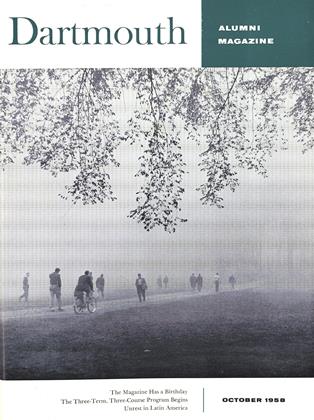Edited by Thomas H. Johnson '25. Cambridge: Harvard University Press, 1958. 5 vols. $25.00.
The word "definitive" is one which requires both restrained and discriminating application where biographical or literary works are concerned. Yet "definitive," with the full force of its meaning, can perhaps properly be called into play to characterize the products of the scholarship that Mr. Johnson has focussed on Emily Dickinson. His is an accomplishment that has recently been sweepingly defined: "There is no greater achievement of editing and research in the field of American literature."
The Letters of Emily Dickinson are companion volumes to Mr. Johnson's threevolume edition of The Poems of EmilyDickinson (Harvard, 1955) and his interpretive biography of the poet (also issued by Harvard in 1955), and they form the culmination of more than seven years of labor on her life and writing.
"Letter writing," Mr. Johnson points out, "became a part of Emily Dickinson's life while she was still a child. Her need of contact with those she loved led her to set whole mornings or afternoons aside to pen with intimate sprightliness missives of considerable length.... She was only eleven when she wrote the earliest surviving letter, in which she expresses herself with ease and charming felicity."
In later years, when in early womanhood she secluded herself within the precincts of her Amherst home, determined never voluntarily to leave it again, letters became even more important to her. They were a central and vital factor in her life.
There are included in the three volumes of the present set some 1150 letters and prose fragments which not only form a record of the events and influences in their writer's life, but provide the means of incomparably penetrating insights into her personality and the quality and character of her thought. Whether written during her juvenile period or later when her epistles became briefer and more deliberately phrased, there is ever present in the letters an intensity and sensitivity of feeling and a power and well-developed facility of expression.
About one hundred letters are published here for the first time, but there is considerably more new material than that figure would suggest, since a great many letters were previously published with extensive deletions from their text.
The arrangement is essentially a chronological one and each letter is followed by information on ownership or source and previous publication, as well as admirable notes establishing the identity of persons and events that figure in the text or explaining allusions and providing other background matter. The quality of the notes and the nice balance the editor has achieved between them and the letters deserve particular commendation.
The correspondence is divided into twelve sections, each with a short introductory statement in which the editor provides just enough biographical information and commentary to keep the collection firmly tied together into a unit of continuity and give to the reader the data necessary for orientation and clear understanding.
 View Full Issue
View Full Issue
More From This Issue
-
 Feature
FeatureUnrest in Latin America
October 1958 By RICHARD B. McCORNACK -
 Feature
FeatureThe Magazine Has A Birthday
October 1958 By C.E.W. -
 Feature
FeatureHIS JOB Is Running Rockefeller Center
October 1958 By JAMES B. FISHER '54 -
 Feature
FeatureIndependence in Learning
October 1958 -
 Class Notes
Class Notes1953
October 1958 By LT. FREDERICK H. STEPHENS JR., CHARLES B. BUCHANAN -
 Class Notes
Class Notes1921
October 1958 By JOHN HURD, LINCOLN H. WELD
Books
-
 Books
BooksL'AMOUR EN BOUTON,
January 1951 By ARTHUR M. WILSON -
 Books
BooksFRANCISCAN AWATOVI
March 1950 By Elmer Harp Jr. -
 Books
BooksThe Private Papa
June 1981 By J. D. O'Hara Jr. '53 -
 Books
BooksTHE STORY OF AMERICAN DISSENT.
November 1934 By Malcolm Keir -
 Books
BooksITALIAN ODYSSEY, AN EAR TO THE WIND.
OCTOBER 1969 By PENNINGTON HAILE '24 -
 Books
BooksBASIC SOURCES OF THE JUDAEO-CHRISTIAN TRADITION.
NOVEMBER 1962 By ROY B. CHAMBERLIN


